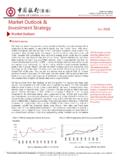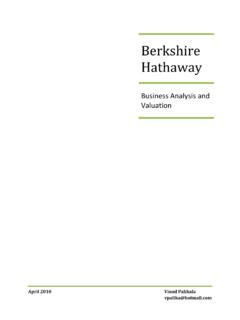Transcription of Methods of Loan Guarantee Valuation and …
1 Methods of loan Guarantee Valuation and AccountingAshoka Mody and Dilip PatroNovember 1996 Partial government guarantees of private financing can be an effective tool formaintaining public-private partnerships. loan guarantees that cover some or all of the risk ofrepayment are frequently used by governments to pursue policy objectives supporting priorityinfrastructure projects or corporations in financial distress. Studies show that guarantees areextremely valuable the value of a Guarantee increases with the risk of the underlying asset orcredit, the size of the investment, and the time to maturity.
2 The flip side of a Guarantee s value toa lender is a cost to the Government. Such a cost is not explicit, but is nevertheless real. To theextent, these liabilities have a subsidy component, careful risk sharing, Valuation , andaccounting mechanisms are important. This paper describes Methods of Guarantee Valuation ,reports estimates of Guarantee values in different settings, and summarizes Methods of guaranteeaccounting and their implications. While the old method recorded guarantees only when adefault occurred, new Methods seek to anticipate losses, create reserves, and channel fundsthrough transparent accounts to ensure that costs of guarantees are evident to decision describe the federal Credit Reform Act of 1990 to illustrate accounting guarantees that cover some or all of the risk of debt repayment have, in the past, beenfrequently used by governments to pursue a variety of policy objectives, including protectingbank depositors, promoting exports and foreign investment by domestic firms, supporting ailingindustrial sectors.
3 And even bailing out specific firms in financial distress. Today, an importantgoal is the financing of infrastructure. Rather than directly financing infrastructure projects,governments, especially in developing countries, are increasingly using guarantees to stimulateprivate lending to such projects. Partial guarantees or guarantees targeted to specific policy orregulatory risks inherent in infrastructure sectors mitigate those risks that the private sectorcannot evaluate or will not bear. At the same time, such partial guarantees can substantiallydiminish the financial obligation of the government, where the only alternative is for theMethods of loan Guarantee Valuation and Accounting2government to fully finance the project and bear all find that loan guarantees are of significant value, providing substantialcomfort to lenders, especially as the underlying risk and the term of the loan increase.
4 Aguarantee s value to a lender, however, implies a cost to the government. Such a cost, and theconsequent obligation, are not always explicit, but are nevertheless real. When providing aguarantee, a government incurs a contingent liability, or a liability that is conditional on somefuture event. Although contingent liabilities do not demand immediate payment, futureobligations are expected, and these require careful accounting and administration. When themagnitudes of liabilities incurred are large and not adequately accounted for, payments resultingfrom default can result in significant intergenerational inequity (Iden 1990).This paper does not examine the arguments for supporting specific policy objectivesthrough guarantees.
5 Rather it takes as its starting point the provision of a Guarantee and focuseson the requirements for managing obligations that consequently accrue. To that end, the paper:(1) highlights the financial characteristics of guarantees; (2) describes Methods of guaranteevaluation and reports estimates of Guarantee values in different settings, and (3) summarizesexisting and emerging Methods of Guarantee governments do not account for the contingent liabilities that are incurred when aninvestment is guaranteed. Government budgets are typically on a cash basis, thus a direct loan of$100 made from government revenues is recorded as an outflow of $100.
6 But a governmentguarantee of a $100 loan made by a private lender is recorded as a zero outlay, since nothing hasbeen spent in that accounting period. The Guarantee is accounted for only when a default occursand the obligation has to be honored. Fiscal prudence is maintained by setting a largely arbitraryupper limit on the total value of guarantees. Guarantees are counted against this upper limit invarious ways, including, in extreme cases, at the full face value of the underlying loansguaranteed plus interest payments due, even though the expected probability of default issignificantly less than shows that guarantees do get called and, along with their significant implicitMethods of loan Guarantee Valuation and Accounting3subsidy values, have a serious impact on budgeting.
7 Defaults on guaranteed loans forinfrastructure projects in the nineteenth century arose partly from poor design of guarantees allrisks were transferred to the government but in recent decades, guarantees have been animportant policy instrument in the United States (Eichengreen 1995). Guarantee programsinclude loan guarantees to corporations, deposit insurance, mortgage guarantees, and trade andexchange rate guarantees. During the 1970s, contingent liabilities of the government grew atan extremely high rate. These liabilities did not show up explicitly in the budget; however duringthe late 1980s, policy makers and the public felt the cost of such liabilities, particularly of thefederal deposit insurance scheme that followed the crisis in the savings and loan industry(Bosworth, Carron and Rhyne 1987, Iden 1990, CBO 1989, and Towe 1993).
8 That crisis beganthe search for more prudent accounting concept Methods . Similarly, defaults on loan guaranteesin Canada during the 1980s led to new budgetary practices for accounting of systematic accounting system is needed to accurately reflect government liabilities andto improve the government's resource allocation. Guarantees should be recorded in the budget atthe present value of their expected payments minus Guarantee fees received. Such a methodologycreates a more accurate picture of government liabilities (and implicit subsidies) and provides thegovernment with a tool to decide between alternative Such procedures have beenimplemented, to varying degrees, in the United States in 1992 under the requirements of theCredit Reform Act and also in Canada.
9 Other countries considering increased use of guaranteesare actively examining the prospects of introducing new accounting methodology for the introducing the new Methods revealed significant hidden subsidies and redirectedfunding among competing paper brings together two streams of research on valuing guarantees and onaccounting for government's contingent liabilities. Although a significant body of research exists 1 Similarly, loans provided by the government should, for budgetary purposes, be recorded at the value of the subsidyrather than the full value of the principal of loan Guarantee Valuation and Accounting4on valuing contingent claims such as futures, options contracts, and other exotic derivativesecurities, the application of these pricing techniques to government liabilities is recent (Lewisand Pennachi 1994; Kau, Keenan and Muller 1993; Ronn and Verma 1986).
10 Researchers havealso independently looked at the issue of budgeting for such liabilities. However, there is nosingle treatment of Valuation and accounting of contingent liabilities. Bringing the studiestogether in one overview increases understanding of contingent claims and should also providepolicymakers with benchmarks and guidelines for decision making. Examples are drawnprimarily from developed countries especially the United States where substantial experiencehas accumulated. The analytical Methods and findings should be of value to developingcountries, too, since their use of guarantees is paper describes the financial characteristics of guarantees, and then summarizesseveral studies evaluating gains from loan guarantees.















